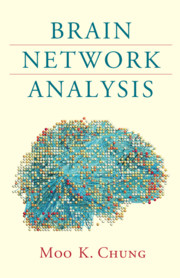Refine listing
Actions for selected content:
1413 results in Ebooks in network science
6 - Network Simulations
-
- Book:
- Brain Network Analysis
- Published online:
- 10 June 2019
- Print publication:
- 27 June 2019, pp 129-155
-
- Chapter
- Export citation
3 - Graph Theory
-
- Book:
- Brain Network Analysis
- Published online:
- 10 June 2019
- Print publication:
- 27 June 2019, pp 61-75
-
- Chapter
- Export citation
8 - Diffusions on Graphs
-
- Book:
- Brain Network Analysis
- Published online:
- 10 June 2019
- Print publication:
- 27 June 2019, pp 180-206
-
- Chapter
- Export citation
Contents
-
- Book:
- Brain Network Analysis
- Published online:
- 10 June 2019
- Print publication:
- 27 June 2019, pp vii-x
-
- Chapter
- Export citation
10 - Brain Network Distances
-
- Book:
- Brain Network Analysis
- Published online:
- 10 June 2019
- Print publication:
- 27 June 2019, pp 226-245
-
- Chapter
- Export citation
Frontmatter
-
- Book:
- Brain Network Analysis
- Published online:
- 10 June 2019
- Print publication:
- 27 June 2019, pp i-iv
-
- Chapter
- Export citation
Dedication
-
- Book:
- Brain Network Analysis
- Published online:
- 10 June 2019
- Print publication:
- 27 June 2019, pp v-vi
-
- Chapter
- Export citation
Index
-
- Book:
- Brain Network Analysis
- Published online:
- 10 June 2019
- Print publication:
- 27 June 2019, pp 326-330
-
- Chapter
- Export citation
Bibliography
-
- Book:
- Brain Network Analysis
- Published online:
- 10 June 2019
- Print publication:
- 27 June 2019, pp 302-325
-
- Chapter
- Export citation
12 - Series Expansion of Connectivity Matrices
-
- Book:
- Brain Network Analysis
- Published online:
- 10 June 2019
- Print publication:
- 27 June 2019, pp 269-291
-
- Chapter
- Export citation
11 - Combinatorial Inferences for Networks
-
- Book:
- Brain Network Analysis
- Published online:
- 10 June 2019
- Print publication:
- 27 June 2019, pp 246-268
-
- Chapter
- Export citation
Preface
-
- Book:
- Brain Network Analysis
- Published online:
- 10 June 2019
- Print publication:
- 27 June 2019, pp xi-xii
-
- Chapter
- Export citation
2 - Brain Network Nodes and Edges
-
- Book:
- Brain Network Analysis
- Published online:
- 10 June 2019
- Print publication:
- 27 June 2019, pp 27-60
-
- Chapter
- Export citation
7 - Persistent Homology
-
- Book:
- Brain Network Analysis
- Published online:
- 10 June 2019
- Print publication:
- 27 June 2019, pp 156-179
-
- Chapter
- Export citation
4 - Correlation Networks
-
- Book:
- Brain Network Analysis
- Published online:
- 10 June 2019
- Print publication:
- 27 June 2019, pp 76-107
-
- Chapter
- Export citation
13 - Dynamic Network Models
-
- Book:
- Brain Network Analysis
- Published online:
- 10 June 2019
- Print publication:
- 27 June 2019, pp 292-301
-
- Chapter
- Export citation

Brain Network Analysis
-
- Published online:
- 10 June 2019
- Print publication:
- 27 June 2019
6 - Unsupervised Learning: Cluster Analysis
-
- Book:
- Analyzing Network Data in Biology and Medicine
- Published online:
- 18 March 2019
- Print publication:
- 28 March 2019, pp 241-285
-
- Chapter
- Export citation
7 - Machine Learning for Data Integration in Cancer Precision Medicine: Matrix Factorization Approaches
-
- Book:
- Analyzing Network Data in Biology and Medicine
- Published online:
- 18 March 2019
- Print publication:
- 28 March 2019, pp 286-312
-
- Chapter
- Export citation
Frontmatter
-
- Book:
- Analyzing Network Data in Biology and Medicine
- Published online:
- 18 March 2019
- Print publication:
- 28 March 2019, pp i-iv
-
- Chapter
- Export citation
